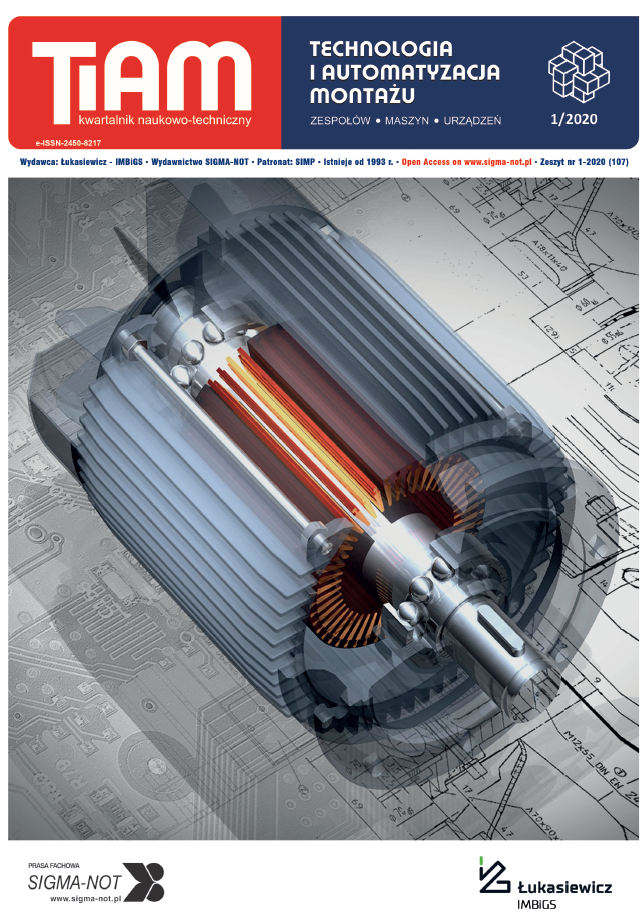Abstract
Economic development requires from production companies to use more and more effective production methods. The growing demand for goods requires from them to reduce the lead time and to produce products of the best quality and competitive price. One of the problems of production lines is their proper balance. Balancing the production line consists in finding the optimal order of performed operations and assigning operations to individual operations in such a way, that work on positions is comparable. In this way, it is strive to minimize machine downtime and to distribute the work evenly between them. In the work, the performance analysis of the assembly line was made on the example of a selected product using three methods of balancing: the experimental method, the RPW (Ranked Positional Weight) heuristic method and SPT (Shortest Processing Time) method. The obtained results were analyzed and solutions were proposed to improve the work of the line.
This is an Open Access article distributed under the terms of the Creative Commons Attribution License CC BY 4.0 (https://creativecommons.org/licenses/by/4.0/)
References
Adil B., Türkay D. 2009. “Simple and u-type assem¬bly line balancing by using an ant colony based algo-rithm”. Mathematical and Computational Applications 14(1): 1-12.
Grzechca W. 2015. “Balancing of the bilateral as¬sembly line taking into account costs”. Logistyka (02): 211 - 220.
Grzechca W. 2007. “Balancing the assembly line inc¬luding costs”. PAK (08): 10 - 12.
Grzechca W. 2012. “JUST IN TIME strategy in the problem of assembly line balancing”. Logistyka (02): 623 - 632.
Grzechca W. 2014. “Method of selecting and asses¬sing assembly line structure”. Mechanik (07): 209 - 216.
Grzechca W. 2014. “Method of selecting and asses¬sing the structure of the assembly line”. Mechanik (07): 209 - 216.
Ismail N., Hamedi M., Esmaeilian G. R., Hamedi M. 2011. Balancing of parallel assembly lines with mixed-model product. International Conference on Management and Artificial Intelligence IPEDR, vol.6. Bali, Indonesia: IACSIT Press.
Kowalski T. 2006. Technology and automation of machine assembly. Warszawa: Oficyna Wydaw. Po-litechniki Warszawskiej.
Marecki F. 1986. Mathematical models and algo¬rithms for the allocation of operations and resources on the assembly line. Gliwice: Department of Publi¬cations of the Silesian University of Technology.
Scholl A. 1999. Balancing and Sequencing of As¬sembly Lines. Heidelberg: Physica-Verlag.
Sharma P., Thakar G., Gupta R.C. 2014. “Evaluation of multi criteria assembly line balancing by mcdm approaches: A conceptual review”. International Jo¬urnal for Quality Research 8(1) 87-106.
Sivasankaran P., Shahabudeen P. 2017. “Compari¬son of Single Model and Multi-Model Assembly Line Balancing Solutions”. International Journal of Com¬putational Intelligence Research 13(8): 1829-1850.
Thomopoulos N. T. 2014. Assembly Line Planning and Control. Switzerland: Springer International Pu-blishing.
Vishnu Raj A. S., Jeeno Mathew, Peter Jose, Gishnu Sivan. 2016. “Optimization of Cycle Time in an As¬sembly Line Balancing Problem”. Global Colloquium in Recent Advancement and Effectual Researches in Engineering, Science and Technology (RAEREST 2016), Procedia Technology 25: 1146 – 1153.
Yazdanparast V., Hajihosseini H., Bahalke A. 2011. “Cost Oriented Assembly Line Balancing Problem with Sequence Dependent Setup Times”. Australian Journal of Basic and Applied Sciences 5(9): 878- 884.


